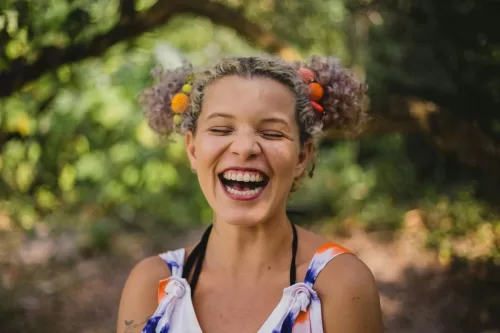Individuation: Why Standing Up For Yourself is So Powerful

In the mode of You Only Live Once (YOLO), and as long as it’s safe, legal, and not harming yourself or others … try it, enjoy it, and do everything to find out what makes you happy. Individuation is what leads to joy, and standing up for yourself and finding your way means you can have a lifetime of doing those things and getting really good at them.
Whether it’s painting, filmmaking, building models, skydiving, dancing, or collecting, you do you and thrive by engaging in whatever makes you smile! It is literally that simple!
Live your life filled with accepting yourself and having no regrets, especially if you’ve had extra challenges on the way. Then, you can later look back and say you had a great ride. And, isn’t having those experiences of finding enjoyment and satisfaction all that anyone truly wants?
Be Uniquely You and Embrace Individuation
For those on the autism spectrum, being “different” is a way of life. Autism is a neurological condition that affects how a person communicates, socializes, and perceives the world around them.
The autism spectrum is wide and varied, with some individuals requiring substantial support and others living entirely independently. While autism presents challenges, it also allows for a unique way of thinking and experiencing life that many have learned to celebrate.
Many individuals with autism have fully embraced their individuality and found avenues to outwardly express the qualities, perspectives, and experiences that make them who they are. Because of an autism lens, many on the spectrum view the world differently and are less bound by social norms and traditions than others may feel bound to follow.
And that can be a great thing because simply put, being unique can make the world a better place!
READ MORE: Autism on the Brain – Unpacking the Meaning Behind Neurodiversity
Here are some of the ways members of the autism community celebrate being unique:
Fashion Expression Promotes Being Uniquely You
One of the most visible ways people with autism celebrate their individuality is through fashion and personal style. Sensory processing differences are common on the spectrum, which can make someone highly attuned to certain fabrics, textures, fits, or accessories.
Some may gravitate towards soft, comfortable materials like cotton or fleece because they find coarse textures overstimulating. Others may prefer compression clothing that provides a calming, grounding sensation on the body. Weighted blankets, vests, and other products designed for sensory input can become part of an individual’s daily outfit and routine.
Many on the spectrum don’t feel bound by traditional fashion rules or societal expectations about colors, patterns, or styles that should be “masculine” or “feminine.” They may opt for highly vibrant colors, bold prints, and unique combinations of clothing items that allow them to outwardly reflect their inner experience of the world and celebrate being “uniquely you.” Dressing in a way that is comfortable yet expressive is one way they remain true to themselves.
READ MORE: Autism Clothing for Sensitive Skin Can Enhance Quality of Life
Special Interests and Careers That Showcase Being Uniquely You

Special interests among autistic individuals run the gamut, both in subject matter and intensity. A person may become consumed with learning everything about dinosaurs, vintage computers, Japanese culture, Broadway musicals, particle physics, or atmospheric conditions. They may fill volumes of notebooks with facts and figures, Indi-movies with painstaking detail, or Rock songs about every species and historical event related to their topic of interest.
While some stigma surrounds the individuation of special interests and the level of passion involved, many in the autism community have learned to fully embrace these focused obsessions. They recognize the incredible depth of knowledge and uncommon skill they gain from their fixation on a subject. In fact, autism researchers and clinicians now encourage special interests as a way to cultivate independence and self-determination.
Special interests frequently lead individuals with autism to highly successful careers where they can immerse themselves in their passion daily. For example, someone obsessed with trains may find their calling as an engineer, conductor, railway historian, or transportation specialist. For me, it’s my fascination with AI.
A person with photographic mastery may become a photographer or artist. Another who loves science may end up a professor or lead researcher In a particular field of study. Aligning one’s profession with one’s deepest interests and strengths is incredibly rewarding and a way of standing up for yourself and honoring a core part of what makes you “uniquely you!”
READ MORE: Neurodiversity in the Workplace and Hearing the Words, ‘You’re Hired!’
Accepting Yourself with Body Movement and Stimming
Repetitive body movements like hand flapping, rocking, pacing, or vocal stimming (repeating certain sounds, words, or phrases) are self-regulatory behaviors commonly exhibited by people on the autism spectrum. These “stims” help them self-soothe, re-center in overwhelming situations, express emotions, and engage with their bodies and surroundings in a way that feels natural.
For a long time, stimming was discouraged and viewed in a negative light. However, the autism community has begun to embrace stimming behaviors as part of the beautifully unique way their minds and bodies experience the world. Organizations like the Autism Self-Advocacy Network actively work to destigmatize stimming and recognize it as an important form of self-expression of standing up for yourself and being unique.
Rather than attempting to camouflage or suppress their need to stim, many individuals proudly stim in public as a way to celebrate this aspect of being autistic. They may share videos of their stimming on social media, use pop culture references related to stimming on clothing or accessories, or simply make no effort to stifle the impulse. Openly engaging in behaviors that come naturally and provide a sense of calm or joy is yet another way to honor one’s individuality on the spectrum.
READ MORE: Autistic Stimming Behaviors – Why We Do and How It’s Important
Demonstrating Being Unique Through Creative Pursuits
Art, writing, music, animation, and other creative pursuits have long offered a powerful individuation outlet for people with autism to express their inner worlds. From bestselling autistic authors like Naoki Higashida who wrote The Reason I Jump to prodigious visual artists like Gregory Blackstock, the unique neurology of the autistic mind results in profound and evocative creative works.
Many people on the spectrum possess remarkable abilities in pattern recognition, attention to detail, atypical thought processes, and distinct ways of perceiving reality. These qualities lend themselves well to creative expression through various media. An autistic painter may zoom in on patterns and textures often overlooked. An autistic singer-songwriter may construct melodies and lyrics that authentically capture emotional resonance. An autistic filmmaker may frame scenes in nontraditional yet visually striking ways.
These creative works become an extension of the individual and a window into their inner and outer experience – the two so beautifully intertwined. By pouring their passions, perspectives, and viewpoints onto the canvas, stage, or page, autistic creatives are not just expressing themselves artistically but celebrating their distinctive identity and way of seeing the world.
Organizations like The Art of Autism are dedicated to highlighting the artistic voices and talents of those on the spectrum. Products created by autistic makers from clothing to music to artwork allow them to share their creative spirit with the wider community in a tangible way.
READ MORE: Imagination and Creativity Explained – How Neurodiversity Can Fuel the Arts
Autism Identity and Pride That Showcase Being Unique

The rise of disability pride, neurodiversity acceptance, and autistic self-advocacy movements has allowed people on the spectrum to develop a positive sense of identity and pride in being unique. This makes celebrating one’s individuality feel empowering rather than an act of acquiescence to a deficit or impairment. Increasingly, autistic self-advocates and allies are using symbols like the rainbow infinity loop, puzzle pieces, or phrases like “different, not less” to outwardly signal autistic identity and pride.
In their unique ways, people with autism (like me) are rejecting the notion that they must fundamentally change or conform to be valid. By recognizing their remarkable strengths and finding creative avenues to fully embrace who they are, the autism community reminds the world that “different” is inherently valuable. Their staunch willingness to unapologetically celebrate their identities and individuality provides an empowering example for all.
READ MORE: Learn How to Love Yourself – Autism Self-Care Ideas
Sensory-Friendly Spaces and Tools That Help With Accepting Yourself
Given the sensory processing differences common in autism, many individuals on the spectrum have pursued individuation creation of sensory-friendly environments, products, and tools that allow them to engage with the world more comfortably.
Some autistic adults and families have renovated living spaces with adjustable lighting, noise insulation, calming colors, and minimalist design elements to reduce overstimulation. Sensory rooms with different textured objects, rocking chairs, trampolines, and sound/video equipment provide a customized sensory experience. Wearing noise-canceling headphones in loud public spaces is another way to make the surrounding environment more manageable.
There are also a growing number of “autism-friendly” options for entertainment and leisure activities. Some movie theaters offer sensory-friendly screenings with the lights up and sound lowered. Museums may have hourly windows of adjusted lighting and quieter spaces to cater to visitors on the spectrum. Amusement parks can provide pass systems to minimize stressful waits in overwhelming lines and crowds.
In addition, a wide range of toys, tools, and therapeutic products have emerged to provide healthy sensory input for autistic children and adults. Squishy fidget toys, weighted blankets and lap pads, and swinging chairs are just a few examples that can be used at home, school, or in the workplace for self-regulation. Chewable jewelry designed for oral stimming provides a discreet way to meet this need.
By advocating for these types of autism-friendly environments, events, and products, the community is not just making the world more accessible – they are celebrating the unique sensory needs and self-soothing strategies of autistic experiences. Designing customized solutions allows people on the spectrum to fully embrace the philosophy of “standing up for yourself” and being comfortable with their identities instead of masking differences or avoiding activities.
READ MORE: Sensory Integration Dysfunction? A Sensory Diet Can Change Your Life!
Social Connections through Shared Experiences: Embracing Being Uniquely You
Though autism is often associated with social communication challenges, many individuals on the spectrum find meaningful social connections through bonding over shared experiences, perspectives, and identities.
In-person autism communities, social groups, and meetup events based on special interests provide invaluable opportunities for interaction on a more level playing field. With a group of like-minded peers, someone may feel free to infodump facts about their favorite sci-fi movies, discuss coping strategies for managing meltdowns, or simply socialize without judgment about atypical mannerisms or conversation styles. These spaces create a sense of belonging centered around authenticity.
Online, there is a vast autistic community across websites, social media, forums, chatrooms, and virtual worlds. People connect through special interest channels, creative collaborations, text-based conversation more conducive to the autistic communication style, and welcoming spaces celebrating neurodiversity. The internet has opened up a new world for autistic people to interact, share perspectives, and embrace individuation and being unique together safely.
Both online and offline community spaces are invaluable for autistic youth and adults to develop self-confidence, self-advocacy skills, and self-acceptance around their uniqueness. Seeing their traits, behaviors, and characteristics reflected in others helps provide a mirror of validation. Through these networks of shared experience, there is power in numbers and inspiration in individuality.
READ MORE: Making a Connection – The Forgotten Joy of Finding Third Places
Autism Celebration Events, Traditions Support Individuation

Each April, Autism Acceptance Month spotlights educational campaigns, fundraisers, artistic showcases, conferences, and other initiatives aimed at fostering inclusion while challenging stigmas and stereotypes. The Autism Society of America organizes awareness walks, the United Nations hosts a World Autism Awareness Day, and individuals participate in social media pushes to share autistic voices and experiences. This serves as a designated time to rally around celebrating differences and push for societal changes.
Additionally, June 18 is annually marked as Autistic Pride Day as declared by autistic self-advocates. This signifies the importance of autistic people taking the lead in movements and conversations centering around autism. Individuals wear symbols like rainbow infinity loops, share stories, and reaffirm pride in identity.
Many families and communities have also developed local traditions like giving out rainbows or puzzle piece icons for children to decorate and display. Arts festivals, talent showcases, and creative workshops allow autistic expression center stage. Some even celebrate with autistic-created recipes or menus to pay tribute to sensory preferences.
Whether on a worldwide scale or grassroots local level, autism celebration events and traditions grant visibility and honor the richness of diversity within the autistic experience. The chance to come together in appreciation of what makes each person unique generates powerful energy that sustains the community’s resilience and hope.
In myriad ways, people with autism are boldly focusing on “standing up for yourself” by celebrating their individuality with creativity, advocacy, and unwavering self-acceptance. By broadcasting their unique identities, they inspire societal changes towards a more inclusive world that celebrates the broad spectrum of neurodiversity as well. When supported in fully being themselves, people on the autism spectrum reveal remarkable capabilities – not despite being different but because of it.
READ MORE: Self-Identity – the Ultimate Guide to Finding Your True Self
Celebrating Authenticity and Standing Up for Yourself
For too long, the story of autism has been defined by deficit perspectives and societal misunderstandings. The autism community’s determination to celebrate individuality flips the narrative. By boldly expressing their individuation and authentic selves through fashion, careers, body movements, artistic pursuits, advocacy, and more, people on the spectrum are rejecting labels as well as pressure to mask their true natures.
Rather than viewing autism as a dysfunction in need of a cure, this vibrant community recognizes their neurological differences as inseparable parts of multi-faceted identities worthy of pride. Their honesty in showing up fully as their unique selves showcases the remarkable capabilities that arise from atypical neurology – from brilliant creative minds to powerful pattern detectors to refreshingly direct communicators.

Every stimming hand flap or rock, every passionate special interest monologue, every autistic-created work of art is an act of self-love and a celebration of the boundless form human diversity can take. Autism acceptance and identity movements send a powerful message: There is beauty and brilliant value in the full spectrum of cognition, communication, and human experience.
By embracing authenticity and individuality, the autism community paves the way for a more inclusive reality where all types of minds and bodies have space to exist as their truest selves. Our collective journeys remind us that honoring each of our unique identities doesn’t just benefit us individually—it benefits us all.
READ MORE: Hope for the Future – Will it Transform the Autism World?
Autism in Adults: Living, Learning, and Overcoming Challenges for a Fulfilled Life
Learn more about autism in adults by reading the articles below.
Autism in adults requires additional support and coping skills to achieve independence in today’s world. Learn more about ways adults can live fulfilled lives and the challenges they face.
- 14 Practical Ways for Staying Motivated to Unlock Full Potential
- Autism and Independence: 7 Skills That Empower Individuals to Thrive
- Dangers of Social Media Addiction: How To Leave the Screens And Face the Real World
- Autism Volunteer Opportunities: 5 Ways Helping Others Fosters Acceptance
- 8 Heartfelt Ways Autism Emotional Support Animals Transform Lives
- Autism in the Future: Optimism for Improved Perception and Embracement
- Autism and AI: 7 Discoveries About the Surprise Pairing and Profound Impact
- Autism After High School: Is College the Next Step?
- Autism vs Asperger’s Syndrome: What You Need to Know
- Autism Disclosure: Is Revealing Your Disorder Helpful or Hurtful?
- Work and Autism: What Employers Should Know About Hiring People Like Me
- Drivers with Autism Can Achieve Success Behind the Wheel
- Exploring the Dark Side of Autism and Aggression